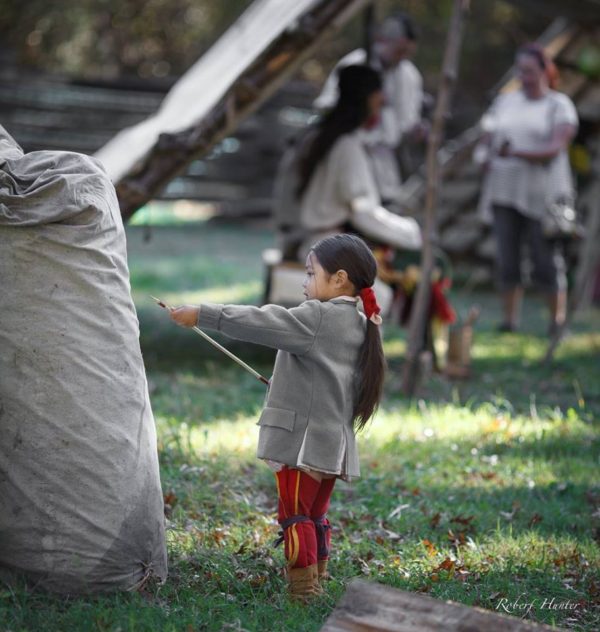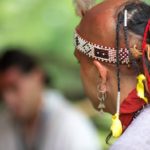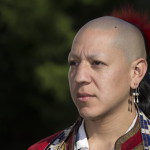
Last week Native peoples integral to early American history returned to Williamsburg in a symbolic reenactment of the visits of 18th-century diplomatic delegations. Relive this amazing event in pictures and video.
The main activity centered on the Indian encampment, where members of the Shawnee, Eastern Shawnee, Seneca-Cayuga, Wyandot, and Delaware nations interpreted aspects of their 18th-century cultures. Williamsburg, as the colonial capital, frequently hosted delegations from hundreds of miles away. This program, titled “Beyond the Ohio: Native Peoples of Virginia’s Old Northwest,” honored that shared history.
Thanks to Rob Hunter for the great photos!
And lest you think that the issues tackled back then have nothing to say to us today, consider what would have been on the 18th-century agenda: the maintenance of borders, forging alliances against common threats, the regulation of trade, and the diplomacy required for different cultural groups to come together to work out disagreements. Seems pretty modern, doesn’t it?
“It was an opportunity to rethink our knowledge of Native America,” said Buck Woodard, who built our American Indian Initiative and currently holds the position of Manager of Interpretive Program Development. “This helps to return native peoples back to the consciousness of Americans, and maybe introduces them to stories they haven’t heard before.”
A years-old tradition was renewed with an offering of tobacco grown at Great Hopes Plantation.
The gift carried a dual symbolism: first, reenacting the historic gift exchange with Native American delegations, but also the building of a relationship between Colonial Williamsburg as an institution and the tribal nations who shared their history and culture. “It shows we’re glad they came,” said Buck, “and we hope they’ll take the gifts back to their homes and think good things about us.”
Reciprocity and gift exchange was a crucial part of Euro-Indian relations in early America, but it remains an important aspect of relationship building today. Buck explained the importance of sharing something that would be valued in both an 18th-century and modern context. In addition to tobacco, previous gifts have included items like blue or red broadcloth for clothing, printed linens, ribbon, even peace medals for Cherokee delegations.
The evening program began with something really special, a thanksgiving address delivered in the Wyandot language. Today the Wyandot people primarily speak French and English; Wyandot is semi-dormant as a spoken language.
Buck worked with Wyandot linguists to incorporate some original language into elements of current programming, and the evening address was the biggest payoff. It’s a prayer to the world, an expression of thanks before beginning the celebration, he explained. “It moves from thank you to all realms of life: animals and plants; wind and earth; sun and moon. It shows where we fit in the cosmology.”
The address set the tone for the evening, featuring songs, stories, and social dances from the Indian nations. There were no strangers, as everyone immersed themselves in the sensory experience: shadows around the flickering fire, rattles punctuating the chanting call-and-response, smoke wafting in the evening’s chill.
The revelry is an experience we hope to duplicate down the road. “It’s about meeting people and getting to know each other,” which makes it an opportunity to unite past and present, as well as people from very different backgrounds, hopefully building a better understanding along the way.


Scott L. Sears says
I think all white and black americans should be taught about the original americans -the brown americans - and their wisdom.
Cindy Schmidt says
Many people don’t seem to think all that much about the fact that Native Americans were here first. They have a history that is just as rich as any culture in Europe.
Ed says
You make an important point, Cindy. I think that the big culprit with that is in our school textbooks! For generations,
they all give a very Euro-centric view of American history, so that’s what so many of our students think how our
history actually happened. And the text books do this in a variety of ways, ranging from the vocabulary that’s used
to flat out lies about how things actually happened.
Tim Burton says
Jeremy Turner brings the accuracy of his ancestors past to present. It;s through his in-depth research and knowledge that we can begin to understand the trials and tribulations of the great North American Indian. Keep up the great work Mr. Turner.
Jeremy says
Thank you, Tim!!!
Robert Reeder says
Will you be having this event next year? If so do you know when so I can plan on attending?
Robert,
We don’t currently have any plans to have this particular program, but only time will tell. We do have plans to continue ramping up Native American programming on a daily basis so that it’s part of the regular landscape in town, and not just a once-in-a-while thing. We want all our guests to be able to learn about this aspect of our history, so the emphasis is on strengthening our core unit in the American Indian Initiative.
I’m proud to know Jeremy Turner and his great family.
Jeremy says
Nia weh, Terry! We are proud to call you our friend!